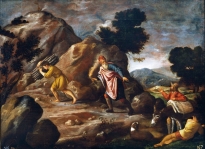Violence texts in the Old Testament in a modern context
The question of the relationship between religion and violence is a frequent topic in contemporary discourse. The problem has been particularly heightened in the wake of the attacks of 11 September 2001. It is no coincidence that the relationship between religion and violence focuses above all on the relationship between Islam and violence.
It may come as a surprise, then, that the 9 February 2016 issue of the British newspaper the Independent publishes the results of a study that comparatively examines the issue of violence and concludes that violence is actually more prevalent in the Bible than in the Koran. Most of the reference texts are undoubtedly from the Old Testament, although this research shows that the New Testament is not lacking in violent texts.
This research examined the references to violence in the two collections (Bible and Qur'an) on a software basis. The method itself leaves much to be desired, which also leaves the results highly questionable. The researcher of rape texts does not distinguish between descriptive (descriptive) and prescriptive (prescriptive) texts. That is to say: a text on violence that paints a historical picture of the situation is considered just as relevant as a text where aggression is ordered by God. However, despite the conclusions, which are far from technically objectionable, the fact remains that violence is a theme that must be taken seriously in the Christian tradition. The history of the church is replete with countless manifestations of violence (violent conversions, religious wars, bloody disputes), and many forms of aggression, even in legitimised versions (e.g. intolerance towards other religions), are not absent from the contemporary church world. All this suggests that the church, or indeed any culture that holds the biblical tradition as a value system at some level, must not only account for its past but also be accountable to the public today for the precise sense in which it still considers the non-violent biblical texts relevant today.
The inevitable linking of religion and violence in society has intensified not only anti-Islam but also anti-Christian and even anti-religion in general. It is striking, however, that this anti-religion is not primarily expressed within the community of those who are professionally engaged in some form of religious studies, but outside this circle, which suggests that there are problems of interpretation and hermeneutics behind the rejection.
As contemporary research points out, the root of the new atheism lies above all in the Old Testament texts of violence. Richard Dawkins argues that the Old Testament God is a 'moral monster', citing biblical texts such as Genesis 22 (the command to sacrifice Isaac) as a classic example of child-molestation. What kind of God, he asks, 'who incurs unbridled wrath whenever his chosen people flirt with a rival god' (Exodus 32)? And, of course, he sees a classic example of a bloodthirsty and xenophobic deity in the 'genocide story' of the destruction of the Canaanite natives (e.g. 1 Samuel 15).
Clearly, the problem raised cannot be resolved at the level of meta-argumentation. To argue that such anti-Christian (or indeed anti-religious) rhetoric is equally manifest in various forms of aggression is not to solve the problem itself. What can we do with these texts of violence? Do religion and violence presuppose each other? The question arises in a context that does not seek a solution in the direction of a Dawkinsian radical break.
Knowing the history of the hermeneutics of violence-texts, it is striking that the above questions arise above all in contexts where the questioner did not grow up in Jewish culture. Such was the case, for example, of Markion in the 2nd century A.D., who broke with the Old Testament tradition in search of a more 'humane' image of God. But how can it be that Jesus Christ, who laid the foundations of the doctrine of the Christian Church, and who - in a traditional reading - not only obviously rejects but explicitly rejects the use of violence within religion, was not alienated from an Old Testament which, according to the Dawkins interpretation, is permeated by the idea of violence? The question then arises: what role does the hermeneutical model play in the interpretation of these texts? Are we not projecting onto these texts interpretative patterns which they do not in fact tolerate? In other words, to what extent does an awareness of these reading models help to make these texts a valuable part of a culture without making them a source of danger to social coexistence?
Research output (Articles)
2020
-
Csaba Balogh: Miért akarta megölni Isten Mózest? A veszélyes Isten képzete az Exodus 4,24–26-ban. In: Studia Doctorum Theologiae Protestantis 11 (2020), 7-37
-
Csaba Balogh: Why Did God Want to Kill Moses? The Image of the Dangerous God in Exodus 4:24-26. In: Sacra Scripta 18 (2020), 198-224
2019
-
Csaba Balogh: Exkluzivizmus, intolerancia és az Ószövetség világa. In: Studia Doctorum Theologiae Protestantis 10 (2019), 21-40
